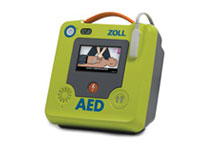Medical emergencies can happen at any time—and the faster care is provided, the better the outcome.
Preparing for cardiac emergencies, traumatic injuries, and other life-threatening medical issues is critical for safety leaders across all industries. ZOLL Public Safety products are designed to offer bystanders the equipment and guidance they need to manage a variety of medical emergencies.
People are often reluctant to help in an emergency if they are not sure what to do. ZOLL® automated external defibrillators (AEDs) and Mobilize Rescue Systems™ provide real-time, step-by-step instructions, giving bystanders the confidence and support needed during an emergency.
All ZOLL defibrillators include integrated feedback technology that helps rescuers deliver high-quality CPR by maintaining an optimal rate and depth of chest compressions. The devices will also deliver a shock if needed. Mobilize Rescue Systems include modern medical supplies and an interactive rescue application, enabling even untrained bystanders to provide potentially life-saving treatment by following the diagnostic prompts in the app. With ZOLL, bystanders always have a partner by their side.
Critical medical emergencies can become fatal during the 7-14 minutes it can take for an ambulance to arrive.1 By ensuring that AEDs and trauma rescue systems are easily accessible, safety leaders can be confident that everyone in their organization is prepared to help right away.
Be an advocate for safety. Ensure that everyone in your organization, community, school, or workplace is prepared to help save lives with a complete public safety rescue station that includes ZOLL AEDs and Mobilize Rescue Systems.
1Mell HK, et al. JAMA Surg. 2017;152:10: 983–984.
Public Safety Featured Products
The Importance of CPR Feedback
High-quality CPR is crucial to any rescue attempt. Many lay rescuers have little experience with CPR, and even professionals benefit from monitoring and support. Real CPR Help® technology in ZOLL’s AEDs provides real-time CPR feedback on compression depth and rate to help rescuers consistently deliver better CPR.









